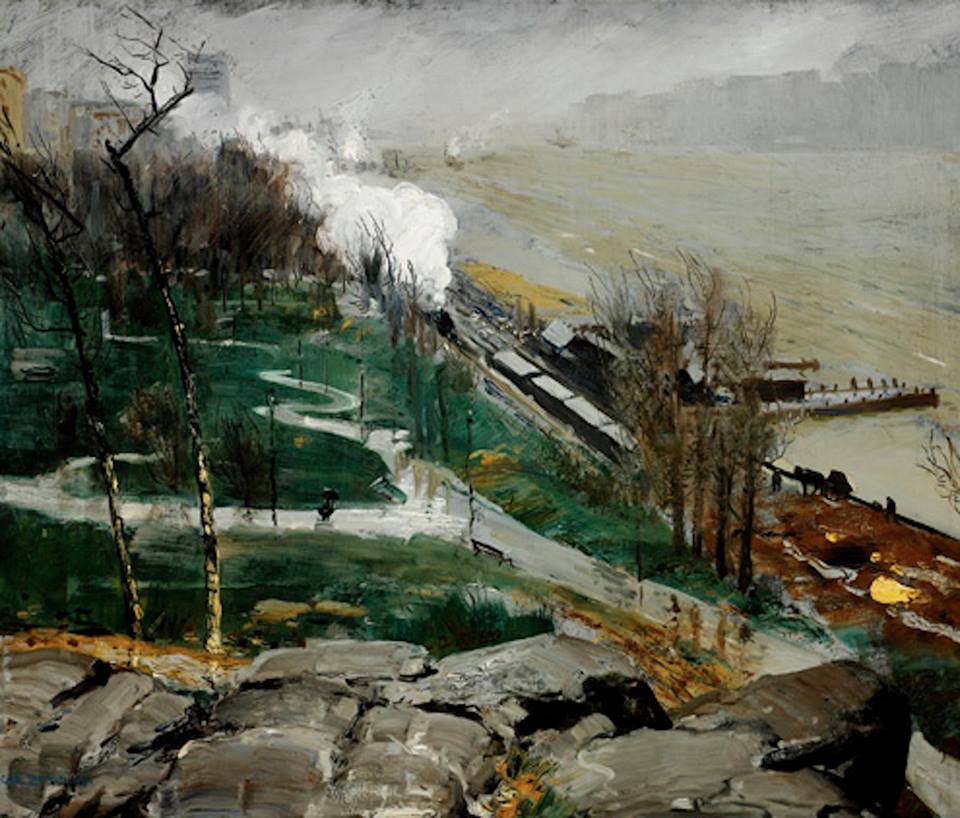During one of my rare forays into social media, I came across a digital posting of a George Bellows painting, "Rain on the River". As I stared at this glistening image — a brushwork tour de force on how to paint wet surfaces — I had a growing feeling that I had been there in person and looked out at that view. That's when I realized it was painted on Mt. Tom, looking south.
For those who don't know Mt. Tom (not the one in Massachusetts) it's a smallish, rocky knoll in New York's Riverside Park at about 83rd Street. Edgar Allen Poe was known to hang out there when he lived nearby, and for good reason: it was a great place to watch the sun set. It's not anymore. I should know; I looked out my window at it for more than a decade. It's now obscured by mature trees, lacks any real visual presence, and no longer offers much of a view — although it's still a nice enough place to visit. Given this unimpressive recent character, I suspect many a park user now wonders how on earth it ever got the grand designation of a "Mount".
One explanation for the currently diminished appearance could be a reduction in stature thanks to Robert Moses, who applied roughly 20 feet of fill to its base. (Imagine a basketball player standing in 2 feet of soil, he might not look so tall anymore.) Standing up top and facing the river, one sees the Warsaw Ghetto Memorial down below. That memorial is on the roof of a train shed installed by Moses. It's another 20 feet or so down to the tracks that once marked the former riverbank. With that additional air space, a Poe, or a Bellows, might feel as if he were standing on a very small mountain — or at least a very tall cliff — overlooking the grandeur of the Hudson.
So when I realized that, wow, this painting was painted on Mt Tom, I reminded myself that the ground plane Bellows depicted over a hundred years ago must now lie under some 20 feet of fill, and that the Henry Hudson Parkway now runs on a train shed over the historic train tracks pictured, and that the park itself now extends another 200 feet out into the water. Yet, it was still so clear to me exactly where that scene was captured. The park paths are roughly the same — they are dictated by the rocky outcrop; the higher buildings on Riverside Drive are still there — taking advantage of spectacular river views; the river itself is still there of course; and the Palisades, one of the oldest geological formations on earth, still loom large across the water.
My recognition of the painting's probable locale points to something bigger than Bellows' skill at capturing the essence of a particular scene, which he accomplished over and over again in and around New York City — a city I know and recognize in his work. The fact that I also recognize the specific spot on which this particular scene was painted — which is now quite altered from the artist's era — points to a larger persistence of place.
I like the ring of that, "persistence of place," but I suppose it might just as aptly be called the resilience of the land, because its based on the earth's remarkable ability to resist change in spite of all the horrible things we do to it. Dig and dump, grade and pave, build and raze. We do this over and over again, just as Robert Moses did to Riverside Park, and yet somehow, the land seems to rebuff our best efforts to truly change it. In many cases, it simply reverts back to a pre-intervention state.
I see this resilience on a small scale in my own work, when in spite of great effort, my designs sometimes fail to completely remedy prior issues. (...Darn that seed bank, those noxious weeds are still coming up! ...Wow, the soil is so hydrophobic where that concrete pad used to be. Hey, why won't my plantings grow where that Norway Maple used to stand? And why do people keep walking over there when I've moved the pathway over here?)
There's a history to places that just can't be ignored. What came before is still there, still making its presence felt, still hidden under the current schmear of topsoil, concrete, and organic debris. No matter how hard we try, bones of older landscapes keep poking through.
Of course, I could be wrong. Someone could write tomorrow, pointing out that Bellows painted "Rain on the River" at a completely different location (sources do confirm it was painted in Riverside Park). But even if it's not exactly the view I think it is, that'll be okay. That small digital image gave me a glimpse back in time to the pre-Moses park. I did see that wider river from a clearer perspective. It's a different park, but it's still my park, the park I know. In my mind's eye anyway, if not actually from the familiar perspective of Mt. Tom.
"Rain on the River" by George Bellows, painted in 1908.

